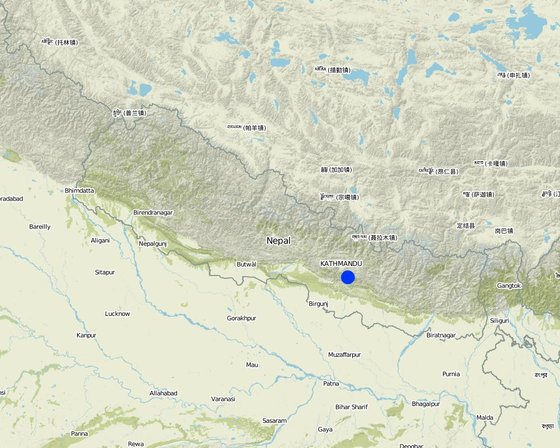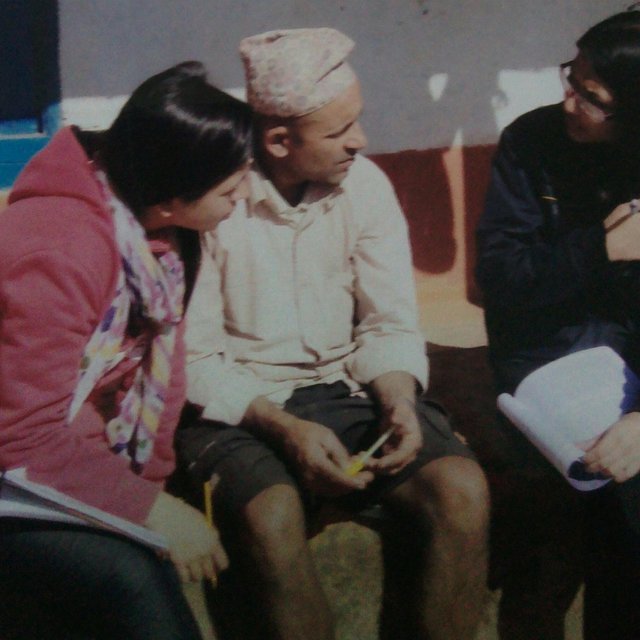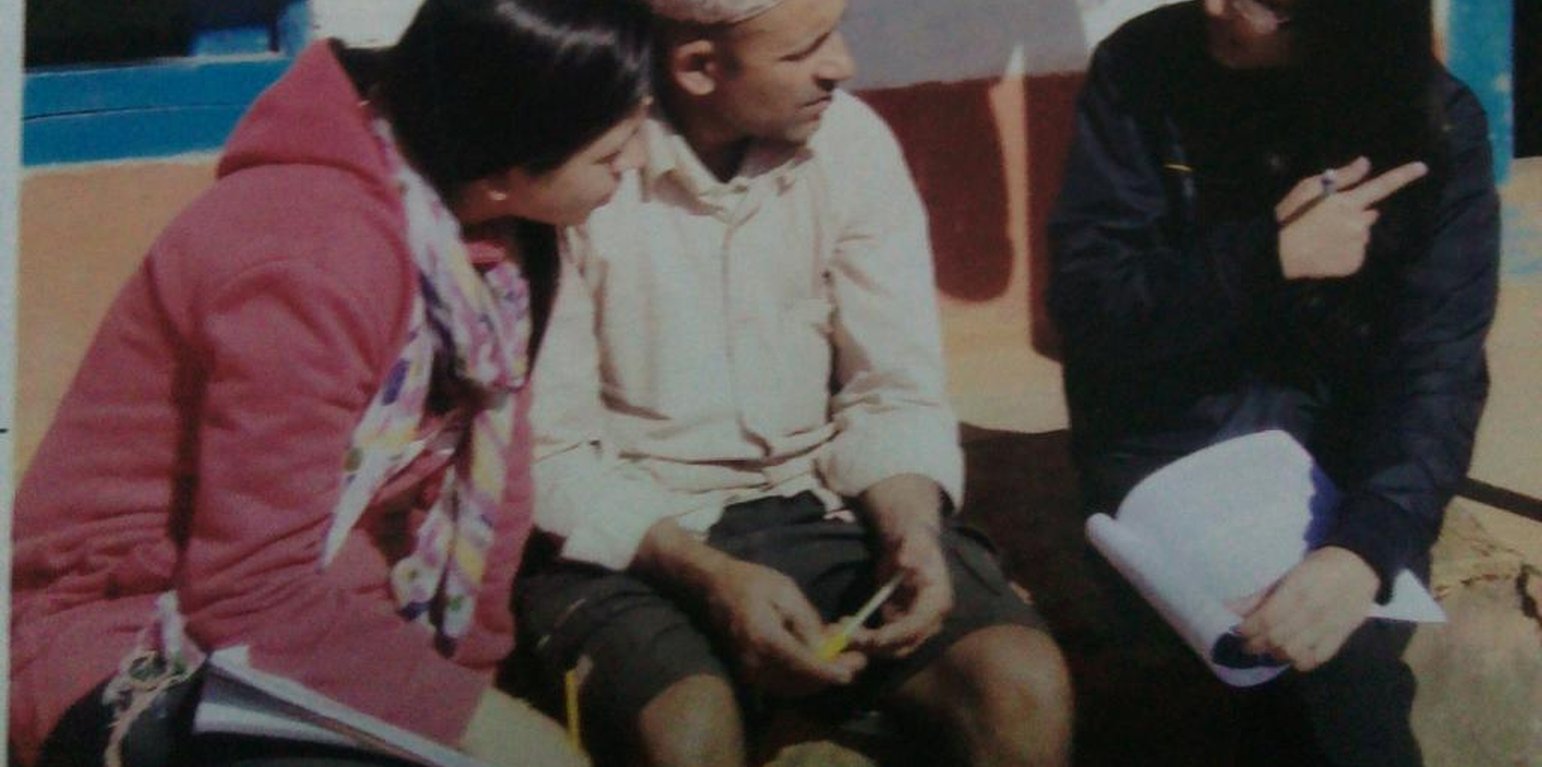Chyamrangbesi - A smoke free zone by using improved cooling stove
(Népal)
Chyamrangbesi- Dhuwa Muta Chhetra
Description
The ways and means used to promote and implement to improved stove to improve human well-being and sustainable land use.
Aims / objectives: The main objectives of the approach was to conserve forest and to improve human well-being
villagers facing major health risks due to smoke like eye itchiness, allergies, bronchitis.
Methods: The idea was proposed by REMRIC Nepal and was supported by Nepal Government. The approach was further enhanced by VDC and few local committes, public participation was an important part of the approach.
Stages of implementation: 1. Research : Questionnaires asked to land users and thier viewpoints noted.
2. Training : REMRIC provided trainiing to 9 people within the village
3. Financial support : Funding provided by VDC, REMRIC and other local bodies. Technician provided.
Role of stakeholders: Private contribution was not made. Organizations provided full financial funding and trained people. Involved organizations also did the research work and training people. A part from this, public participation had the significant role.
Lieu

Lieu: Kavrepalanchok, Népal
Géo-référence des sites sélectionnés
Date de démarrage: 2069
Année de fin de l'Approche: 2069
Type d'Approche
-
traditionnel/ autochtone
-
initiative/ innovation récente locale
-
fondé sur un projet/ programme

Research,Interviews and Questionnaires (Anuja Thapa (Chyamrangbesi))
Objectifs de l'approche et environnement favorable
Principaux objectifs de l'Approche
The Approach focused mainly on SLM with other activities (Forest Production, Manure for agriculture, Improved human health, Kitchen efficiency)
The main objectives of the approach were to improve health hazards caused by the smoke trapped int he room and for forst conservation.
The SLM Approach addressed the following problems: 1. Lack of technical knowledge
2. Lack of cash to invest in SLM
Conditions favorisant la mise en oeuvre de la/(des) Technologie(s) appliquée(s) sous l'Approche
Conditions entravant la mise en oeuvre de la/(des) Technologie(s) appliquée(s) sous l'Approche
-
Disponibilité/ accès aux ressources et services financiers: Land user not ready to invest in experimental technology.
Treatment through the SLM Approach: Local bodies, organization, VDC funded the whole project.
-
Connaissances sur la GDT, accès aux supports techniques: Dur to lack of technical knowledge and information
Treatment through the SLM Approach: REMRIC tarined 9 people; each from one ward
-
Charge de travail, disponibilité de la main-d'œuvre: Soil, brick, rods needed to carry from sometimes far distant areas.
Treatment through the SLM Approach: Land users volunteered to carry items themselves
Participation et rôles des parties prenantes impliquées dans l'Approche
Parties prenantes impliquées dans l'Approche et rôles
| Quels acteurs/ organismes d'exécution ont été impliqués dans l'Approche? |
Spécifiez les parties prenantes |
Décrivez le rôle des parties prenantes |
| exploitants locaux des terres / communautés locales |
Jyotisahakari, Nawa prativa, Chakreshwor, Siddhartha |
Community involvement. As physical activities are more involved, men are majorly involved. 33% only women involved |
| Spécialistes de la GDT/ conseillers agricoles |
REMRIC |
|
| gouvernement local |
Chyamrangbesi VDC |
|
| gouvernement national (planificateurs, décideurs) |
Nepal government |
|
| organisation internationale |
|
|
Participation des exploitants locaux des terres/ communautés locales aux différentes phases de l'Approche
aucun
passive
soutien extérieur
interactive
auto-mobilisation
initiation/ motivation
Public meetings, research questionnaires
planification
Interviews, public meetings
mise en œuvre
responsibility of major and minor steps, casuale labor
suivi/ évaluation
Measurements/observations, interviews/questionnaires
Research
Answer questionnaires, informed about SLM technology, but do not take the final decision.
Prises de décision pour la sélection de la Technologie de GDT
Les décisions ont été prises par
-
les exploitants des terres seuls (auto-initiative)
-
principalement les exploitants des terres soutenus par des spécialistes de la GDT
-
tous les acteurs concernés dans le cadre d'une approche participative
-
principalement les spécialistes de la GDT, après consultation des exploitants des terres
-
les spécialistes de la GDT seuls
-
les responsables politiques/ dirigeants
Les décisions ont été prises sur la base de
-
l'évaluation de connaissances bien documentées en matière de GDT (prises de décision fondées sur des preuves tangibles)?
-
les résultats de recherches?
-
expériences et opinions personnelles (non documentées)
Soutien technique, renforcement des capacités et gestion des connaissances
Les activités ou services suivants ont fait partie de l'approche
-
Renforcement des capacités/ formation
-
Service de conseils
-
Renforcement des institutions (développement organisationnel)
-
Suivi et évaluation
-
Recherche
Renforcement des capacités/ formation
La formation a été dispensée aux parties prenantes suivantes
-
exploitants des terres
-
personnels/ conseillers de terrain
Formats de la formation
-
sur le tas
-
entre agriculteurs (d'exploitants à exploitants)
-
zones de démonstration
-
réunions publiques
-
cours
Sujets abordés
Interviews/questionnaires, setup, construct and design technology
Service de conseils
Le service de conseils était fourni
-
dans les champs des exploitants?
-
dans des centres permanents
Name of method used for advisory service: VDC; Key elements: Structure, Cost; But people have ample technical knowledge, also take advice from neighbours
Advisory service is inadequate to ensure the continuation of land conservation activities; Not that hard or costly to manage the technology. So, self sustaining is sufficient for continuation of technology.
Suivi et évaluation
bio-physical aspects were ad hoc monitored by project staff through measurements; indicators: VDC, Trainees
area treated aspects were ad hoc monitored by project staff through observations; indicators: None
There were few changes in the Approach as a result of monitoring and evaluation: Once a year, REMERIC visits and monitors give suggestions.
There were no changes in the Technology as a result of monitoring and evaluation: Land user self-maintenance
Recherche
La recherche a traité les sujets suivants
-
sociologie
-
économie/ marketing
-
écologie
-
technologie
how many family members in each house
Research was carried out both on station and on-farm
Financement et soutien matériel externe
Budget annuel en dollars US de la composante GDT
-
< 2 000
-
2 000-10 000
-
10 000-100 000
-
100 000-1 000 000
-
> 1 000 000
Precise annual budget: sans objet
Approach costs were met by the following donors: government (Nepal Government); national non-government (REMRIC); local government (district, county, municipality, village etc) (VDC); local community / land user(s) (Chakreshwar, Nawa prativa, Siddhartha, Jyoti sahakari)
Les services ou mesures incitatives suivantes ont été fournis aux exploitants des terres
-
Soutiens financiers/ matériels fournis aux exploitants des terres
-
Subventions pour des intrants spécifiques
-
Crédits
-
Autres incitations ou instruments
Soutiens financiers/ matériels fournis aux exploitants des terres
Technician provided
Analyses d'impact et conclusions
Impacts de l'Approche
Non
Oui, un peu
Oui, modérément
Oui, beaucoup
Est-ce que l'Approche a aidé les exploitants des terres à mettre en œuvre et entretenir les Technologies de GDT?
Less wood consumption so forest conservation. also, the ashes used as manure for agriculture.
Est-ce que l'Approche a autonomisé les groupes socialement et économiquement défavorisés?
Did other land users / projects adopt the Approach?
Principale motivation des exploitants des terres pour mettre en oeuvre la GDT
-
augmenter la production
-
augmenter la rentabilité/ bénéfice, rapport coûts-bénéfices
-
réduire la dégradation des terres
-
réduire les risques de catastrophe
-
réduire la charge de travail
-
paiements/ subventions
-
règles et règlements (amendes)/ application
-
prestige, pression sociale/ cohésion sociale
-
affiliation à un mouvement/ projet/ groupe/ réseaux
-
conscience environnementale
-
coutumes et croyances, morale
-
améliorer les connaissances et compétences en GDT
-
améliorer l'esthétique
-
atténuer les conflits
-
well-being and livelihoods improvement
Durabilité des activités de l'Approche
Les exploitants des terres peuvent-ils poursuivre ce qui a été mis en oeuvre par le biais de l'Approche (sans soutien extérieur) ?
the approach was not difficult to implement. Simple concept was needed. Only cleanliness reqiured.
Conclusions et enseignements tirés
Points forts: point de vue de l'exploitant des terres
-
1. Smoke no longer trapped in the room
2. Less wood consumption
3. Utensils are not damaged (How to sustain/ enhance this strength: Cleaning the stove
plant trees, cooking multiple items at a time)
Points forts: point de vue du compilateur ou d'une autre personne-ressource clé
-
1. Improved kitchen efficiency
2. Better channel for smoke outlet
3. Less wood consumption
4. Manure used for agriculture which kills the pests (How to sustain/ enhance this strength: Cleaning and self-maintainance
Cleaning the outlet pipe from time to time
cooking, boiling water
cleaning and collecting the ashes)
Faiblesses/ inconvénients/ risques: point de vue de l'exploitant des terrescomment surmonter
-
cooks faster than traditional stove however slower than modern stove
Faiblesses/ inconvénients/ risques: point de vue du compilateur ou d'une autre personne-ressource clécomment surmonter
-
1. Smoke outlet system is slightly poor
2. When one spot is used for cooking the other one has to be used too
raise the outletpipe vertically
Some sort of door that can be open and closed when needed.
Références
Date de mise en oeuvre: 18 janvier 2014
Dernière mise à jour: 8 juillet 2017
Personnes-ressources
-
Sabita Aryal (sabita@ku.edu.np) - Spécialiste GDT
Description complète dans la base de données WOCAT
Données de GDT correspondantes
La documentation a été facilitée par
Institution
- Kathmandu University (KU) - Népal
- Sarada Batase Village Development Committee (Sarada Batase VDC) - Népal
Projet





